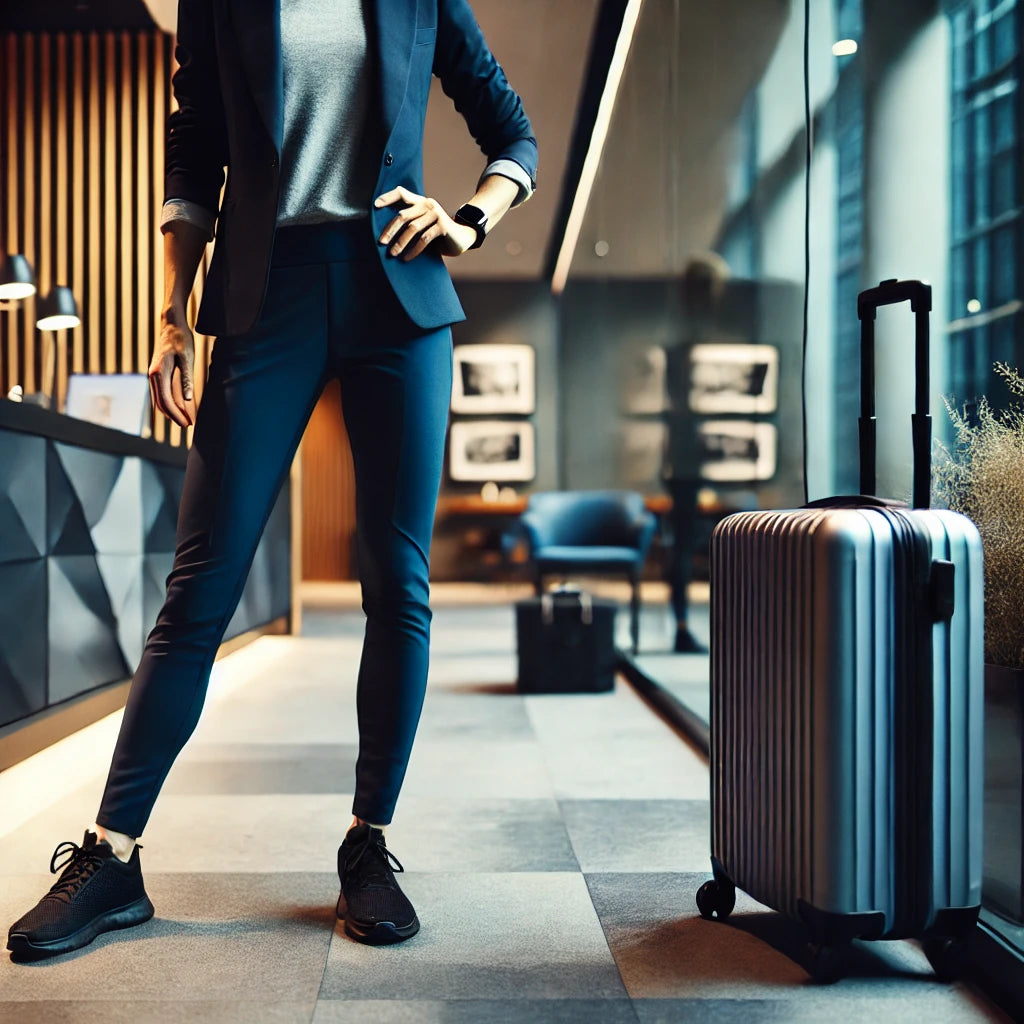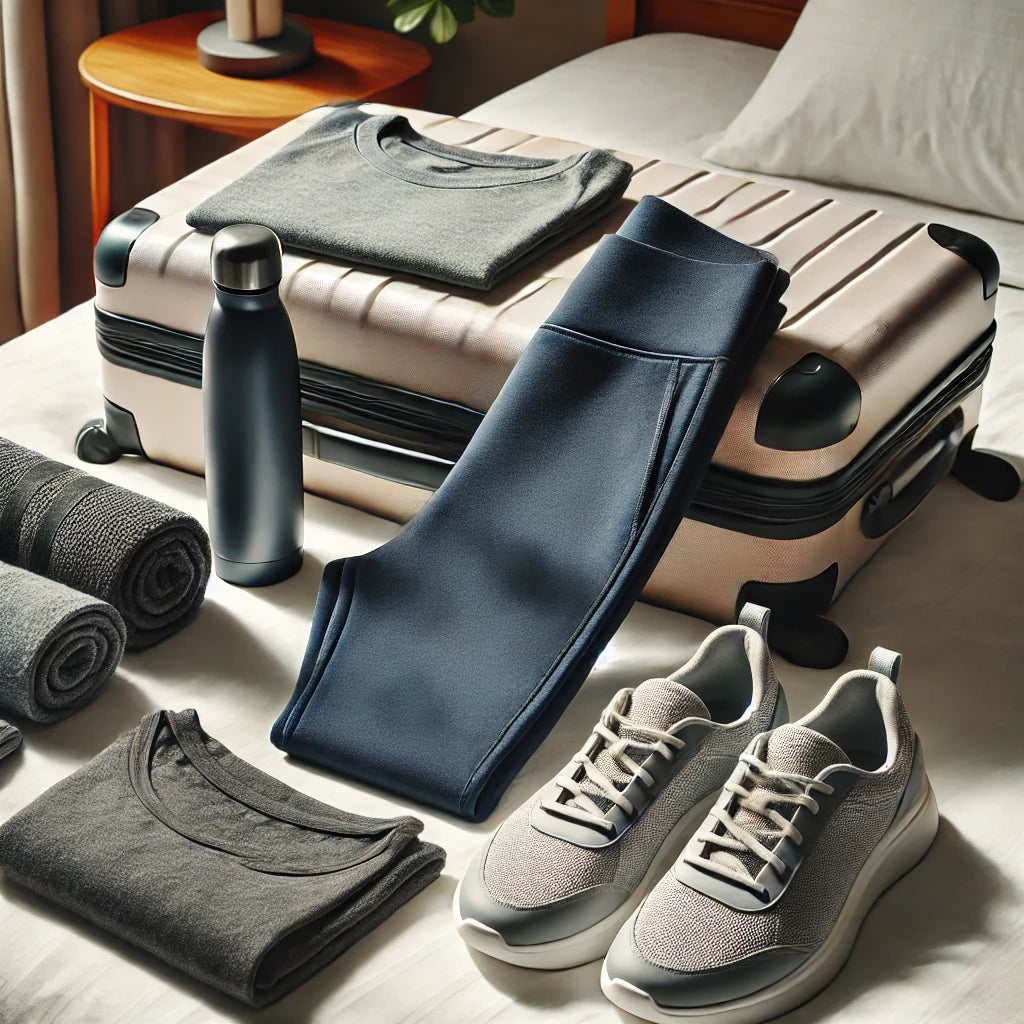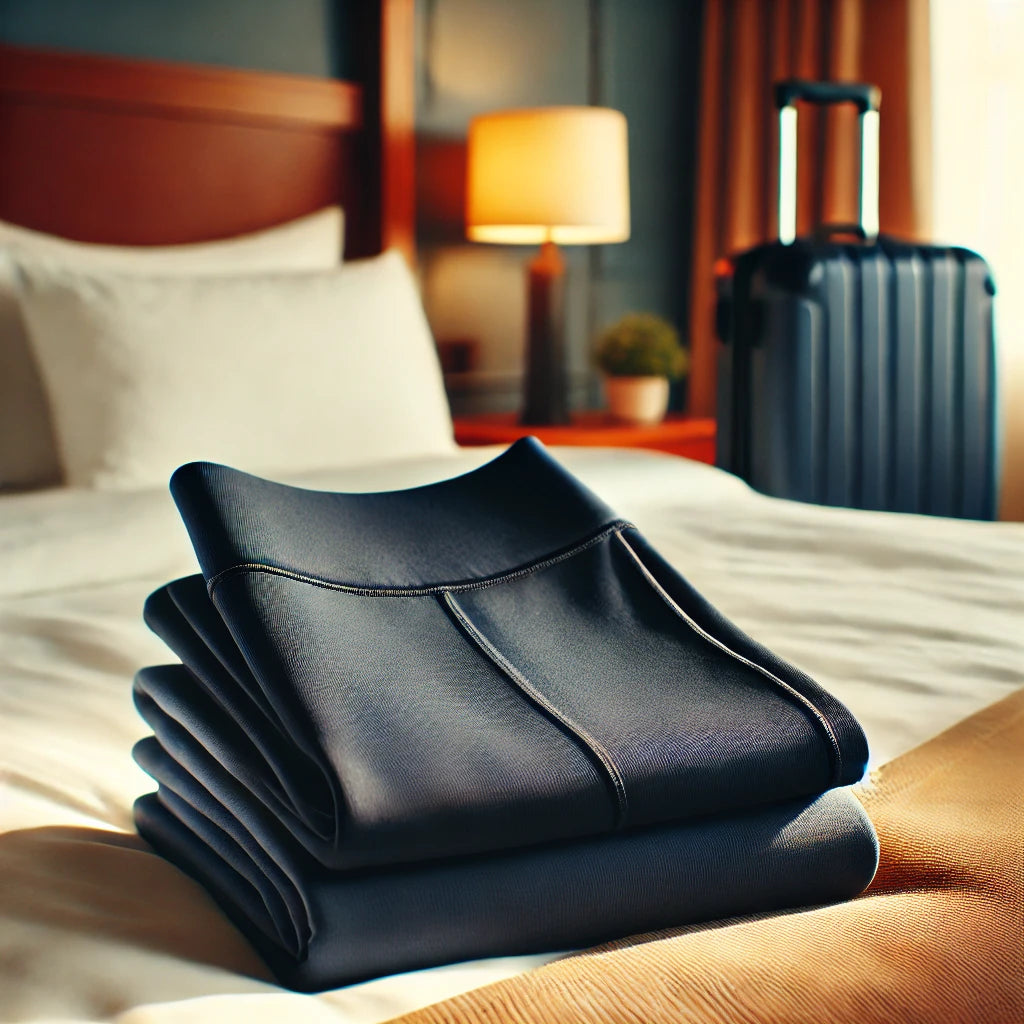Maintaining a consistent fitness routine while traveling can be challenging, especially when access to a gym is limited. However, staying fit on the go doesn't have to be difficult. In this blog post, we’ll explore tailored workout plans specifically designed for hotel room exercises. These exercise workout plans require minimal space and no equipment, making them perfect for traveling professionals. Whether you’re a pilot, flight attendant, or travel nurse, these workout plans for fitness will help you stay on track with your fitness goals and ensure you remain healthy and energized during your travels.

The Importance of Staying Active While Traveling
Traveling often disrupts our regular routines, and one of the first casualties is often our exercise regimen. Yet, maintaining physical activity while on the road is crucial for several reasons:
Physical Health
Regular exercise boosts the immune system, improves cardiovascular health, and helps maintain a healthy weight. This is especially important for frequent travelers who may be more prone to the sedentary lifestyle that long flights and car rides encourage.
Mental Health
Exercise is a proven mood booster. It releases endorphins, reduces stress, and improves sleep—all essential for managing the rigors of travel.
Energy Levels
Staying active keeps your energy levels up, helping you stay alert and focused. This is particularly beneficial for professionals whose jobs require them to be constantly on the go.
Essential Components of an Effective Hotel Room Workout
Before diving into specific workouts, it’s essential to understand the components of an effective fitness routine that can be performed in a hotel room. These workouts should be:
Efficient
Time is often limited when traveling, so workouts should be concise yet effective. High-intensity interval training (HIIT) and circuit training are excellent options.
Comprehensive
A well-rounded workout should include elements of cardiovascular training, strength training, and flexibility exercises. This ensures all aspects of fitness are addressed.
Adaptable
Workouts should be easily modifiable to fit different fitness levels and accommodate the limited space and equipment available in a hotel room.
Warm-Up: Preparing Your Body for Exercise
A proper warm-up is essential to prepare your body for exercise and prevent injury. Here are a few warm-up exercises you can do in your hotel room:
Dynamic Stretching
- Arm Circles: Stand with your feet shoulder-width apart and extend your arms out to the sides. Make small circles with your arms, gradually increasing the size. Do this for 30 seconds in each direction.
- Leg Swings: Hold onto a wall for support. Swing one leg forward and backward in a controlled manner. Do this for 30 seconds on each leg.
- Torso Twists: Stand with your feet hip-width apart and your arms extended in front of you. Twist your torso to the right, then to the left, keeping your hips facing forward. Do this for 1 minute.
Cardio Warm-Up
- High Knees: Jog in place, bringing your knees up to your chest as high as possible. Do this for 1 minute.
- Butt Kicks: Jog in place, kicking your heels up towards your glutes. Do this for 1 minute.
Full-Body Hotel Room Workouts
These workout plans for fitness are designed to be performed in the confined space of a hotel room. They require no equipment and can be modified to suit any fitness level.

Workout Plan 1: HIIT Circuit
High-Intensity Interval Training (HIIT) is an effective way to get a full-body workout in a short amount of time. This HIIT circuit combines cardio and strength exercises to maximize calorie burn and muscle engagement.
- Jump Squats (45 seconds)
- Stand with your feet shoulder-width apart. Lower into a squat position, then explode upwards into a jump. Land softly and immediately lower into the next squat.
- Push-Ups (45 seconds)
- Perform traditional push-ups on your toes or knees. Keep your core tight and your body in a straight line from head to heels.
- Burpees (45 seconds)
- Stand with your feet shoulder-width apart. Lower into a squat, place your hands on the floor, and jump your feet back into a plank position. Perform a push-up, jump your feet back to your hands, and explode into a jump.
- Plank (45 seconds)
- Hold a plank position on your forearms and toes. Keep your body in a straight line from head to heels, and engage your core.
- Mountain Climbers (45 seconds)
- Start in a plank position. Quickly bring one knee to your chest, then switch legs in a running motion.
- Rest (15 seconds)
Repeat the circuit 3-5 times, depending on your fitness level and available time.
Workout Plan 2: Bodyweight Strength Training
This strength training workout uses your body weight to build muscle and improve strength.
- Squats (3 sets of 15 reps)
- Stand with your feet shoulder-width apart. Lower your body into a squat, keeping your back straight and your knees over your toes. Return to the starting position.
- Lunges (3 sets of 15 reps per leg)
- Stand with your feet together. Step forward with one leg and lower your body until both knees are at 90-degree angles. Push through the front heel to return to the starting position.
- Push-Ups (3 sets of 15 reps)
- Perform traditional push-ups on your toes or knees. Keep your core tight and your body in a straight line from head to heels.
- Tricep Dips (3 sets of 15 reps)
- Sit on the edge of a chair or bed with your hands gripping the edge. Slide your butt off the edge and lower your body by bending your elbows. Push back up to the starting position.
- Plank to Push-Up (3 sets of 10 reps)
- Start in a plank position on your forearms. Push up onto your hands, one arm at a time, then lower back down to your forearms. Alternate which arm leads.
- Bicycle Crunches (3 sets of 20 reps)
- Lie on your back with your hands behind your head. Bring one knee to your chest while twisting your opposite elbow towards it. Switch sides in a pedaling motion.
Core-Focused Workouts
A strong core is essential for overall fitness. These workouts target your abdominal muscles and can be done in a small space.
Workout Plan 3: Core Blaster

- Plank (1 minute)
- Hold a plank position on your forearms and toes. Keep your body in a straight line from head to heels, and engage your core.
- Russian Twists (1 minute)
- Sit on the floor with your knees bent and your feet slightly off the ground. Lean back slightly and twist your torso to the right, then to the left, touching the floor beside you with each twist.
- Leg Raises (1 minute)
- Lie on your back with your legs straight. Lift your legs towards the ceiling, keeping them straight, then slowly lower them back down without touching the floor.
- Bicycle Crunches (1 minute)
- Lie on your back with your hands behind your head. Bring one knee to your chest while twisting your opposite elbow towards it. Switch sides in a pedaling motion.
- Mountain Climbers (1 minute)
- Start in a plank position. Quickly bring one knee to your chest, then switch legs in a running motion.
- Side Plank (30 seconds per side)
- Lie on your side with your feet stacked and your forearm on the floor. Lift your hips to form a straight line from head to heels. Hold for 30 seconds, then switch sides.
Repeat this circuit 2-3 times.
Flexibility and Mobility Workouts
Flexibility and mobility are crucial for preventing injuries and maintaining a full range of motion. These workouts incorporate stretching and mobility exercises that can be done in your hotel room.

Workout Plan 4: Stretch and Relax
- Cat-Cow Stretch (1 minute)
- Start on your hands and knees. Inhale and arch your back, dropping your belly towards the floor (Cow). Exhale and round your back, tucking your chin to your chest (Cat). Alternate between these positions.
- Child’s Pose (1 minute)
- Sit back on your heels with your knees apart. Stretch your arms forward and lower your forehead to the floor. Relax and breathe deeply.
- Downward Dog (1 minute)
- Start on your hands and knees. Lift your hips towards the ceiling, straightening your legs and forming an inverted V shape. Press your heels towards the floor and hold.
- Seated Forward Bend (1 minute)
- Sit with your legs straight in front of you. Reach forward and try to touch your toes, keeping your back straight. Hold the stretch.
- Pigeon Pose (1 minute per side)
- Start in a plank position. Bring one knee forward and place it behind your wrist, extending the opposite leg straight back. Lower your hips and stretch forward.
- Butterfly Stretch (1 minute)
- Sit with your feet together and your knees out to the sides. Hold your feet and gently press your knees towards the floor.
Combining Workouts for a Balanced Routine
To achieve a balanced fitness routine, combine different types of workouts throughout the week. Here’s a sample weekly plan:
Monday: HIIT Circuit
- Jump Squats, Push-Ups, Burpees, Plank, Mountain Climbers (Repeat 3-5 times)
Tuesday: Core Blaster
- Plank, Russian Twists, Leg Raises, Bicycle Crunches, Mountain Climbers, Side Plank (Repeat 2-3 times)
Wednesday: Rest or Light Activity
- Light stretching, yoga, or a brisk walk
Thursday: Bodyweight Strength Training
- Squats, Lunges, Push-Ups, Tricep Dips, Plank to Push-Up, Bicycle Crunches (3 sets each)
Friday: Flexibility and Mobility
- Cat-Cow Stretch, Child’s Pose, Downward Dog, Seated Forward Bend, Pigeon Pose, Butterfly Stretch
Saturday: HIIT Circuit
- Jump Squats, Push-Ups, Burpees, Plank, Mountain Climbers (Repeat 3-5 times)
Sunday: Core Blaster
- Plank, Russian Twists, Leg Raises, Bicycle Crunches, Mountain Climbers, Side Plank (Repeat 2-3 times)
Tips for Staying Motivated
Staying motivated to work out while traveling can be tough. Here are some tips to help you stick to your routine:
- Set Clear Goals
- Establish specific, achievable fitness goals. This could be anything from maintaining your current fitness level to improving strength or flexibility.
- Track Your Progress
- Keep a journal or use an app to track your workouts and progress. This can help you stay accountable and motivated.
- Make It Enjoyable
- Choose workouts you enjoy. If you’re having fun, you’re more likely to stick with it.
- Stay Flexible
- Adapt your workout plans to fit your schedule and energy levels. If you’re feeling tired, opt for a lighter workout or focus on stretching.
- Find a Routine
- Establish a consistent routine. Try to work out at the same time each day to build a habit.
- Reward Yourself
- Set up a reward system for reaching your fitness goals. Treat yourself to something special when you hit a milestone.
Staying Hydrated and Energized
In addition to staying active, it's crucial to maintain proper hydration and energy levels, especially while traveling. Dehydration and fatigue can derail your fitness efforts and overall well-being. Here are some tips to help you stay hydrated and energized:
Hydration Tips
- Carry a Reusable Water Bottle
- Having a water bottle with you at all times makes it easier to drink water regularly. Choose a lightweight, durable bottle that's easy to carry.
- Set Reminders
- Use your phone or a hydration app to set reminders to drink water throughout the day.
- Avoid Sugary Drinks
- Stick to water, herbal teas, and beverages with electrolytes. Avoid sugary drinks and sodas, which can lead to dehydration.
- Eat Hydrating Foods
- Incorporate water-rich foods into your diet, such as cucumbers, oranges, strawberries, and watermelon.
- Monitor Your Hydration
- Pay attention to the color of your urine. Light yellow or clear urine typically indicates proper hydration, while dark yellow suggests you need more water.
Nutrition for Energy

- Balanced Meals
- Ensure your meals include a balance of protein, carbohydrates, and healthy fats. This helps maintain steady energy levels.
- Frequent Snacks
- Eat small, healthy snacks throughout the day to keep your energy up. Good options include nuts, fruit, yogurt, and whole-grain crackers.
- Limit Caffeine
- While a cup of coffee can provide a quick energy boost, avoid relying on caffeine too much, as it can lead to energy crashes and disrupt sleep.
- Choose Whole Foods
- Opt for whole, unprocessed foods that provide sustained energy, such as whole grains, lean proteins, and fresh vegetables.
- Stay Consistent
- Try to eat at regular intervals and avoid skipping meals. This helps maintain your metabolism and energy levels.
Sample Meal Plans for Travelers
Maintaining proper nutrition is key to supporting your fitness routine while traveling. Here are some sample meal plans that are easy to prepare and packed with nutrients:
Sample Meal Plan 1
Breakfast: Greek Yogurt Parfait
- Ingredients: Greek yogurt, mixed berries, granola, honey.
- Instructions: Layer Greek yogurt with mixed berries and granola. Drizzle with honey.
Lunch: Quinoa Salad
- Ingredients: Cooked quinoa, cherry tomatoes, cucumber, red onion, feta cheese, olive oil, lemon juice.
- Instructions: Mix cooked quinoa with chopped vegetables and feta. Drizzle with olive oil and lemon juice.
Dinner: Stir-Fried Vegetables with Tofu
- Ingredients: Tofu, mixed vegetables (bell peppers, broccoli, carrots), soy sauce, garlic, ginger, brown rice.
- Instructions: Sauté tofu and vegetables with soy sauce, garlic, and ginger. Serve over brown rice.
Snacks
- Apple slices with almond butter
- Mixed nuts
- Carrot sticks with hummus
Sample Meal Plan 2
Breakfast: Overnight Oats
- Ingredients: Rolled oats, almond milk, chia seeds, sliced banana, honey.
- Instructions: Combine all ingredients in a jar and refrigerate overnight.
Lunch: Turkey and Avocado Wrap
- Ingredients: Whole wheat tortilla, sliced turkey breast, avocado, lettuce, tomato, hummus.
- Instructions: Spread hummus on the tortilla, then layer with turkey, avocado, lettuce, and tomato. Roll up and enjoy.
Dinner: Grilled Chicken and Vegetables
- Ingredients: Chicken breast, zucchini, bell peppers, olive oil, herbs.
- Instructions: Marinate chicken and vegetables in olive oil and herbs. Grill until cooked through.
Snacks
- Greek yogurt with honey
- Trail mix
- Celery sticks with peanut butter
Practical Tips for Eating Healthy While Traveling
Eating healthy while traveling can be challenging, but with some planning and mindful choices, it's entirely doable. Here are practical tips to help you make nutritious choices on the go:
- Research Ahead
- Look up healthy dining options near your hotel or destination before you arrive. Many restaurants now offer healthier choices and clearly marked menu items.
- Prepare Snacks
- Pack healthy snacks for your journey. Having options like nuts, fruits, and protein bars on hand can help you avoid unhealthy airport or convenience store foods.
- Hotel Room Meals
- If your hotel room has a microwave or kitchenette, take advantage of it. You can prepare simple meals like oatmeal, salads, or steamed vegetables.
- Stay Mindful at Restaurants
- When dining out, choose grilled or baked options instead of fried foods. Opt for whole grains and request dressings and sauces on the side.
- Stay Hydrated
- Drinking plenty of water not only keeps you hydrated but can also help control hunger and prevent overeating.
Combining Fitness with Sightseeing
One of the best ways to stay active while traveling is to incorporate fitness into your sightseeing. Here are some creative ways to combine the two:

- Walking Tours
- Explore your destination on foot. Walking tours are a great way to see the sights while getting in some exercise.
- Hiking
- If you're in a location with natural beauty, look for local hiking trails. Hiking provides a great workout and lets you enjoy the outdoors.
- Cycling
- Rent a bike and explore the area. Many cities have bike rental programs and dedicated bike paths.
- Local Fitness Classes
- Check out local fitness classes or studios. Yoga, pilates, or even dance classes can be a fun way to stay active and experience the local culture.
- Hotel Facilities
- If your hotel has a pool or fitness center, take advantage of these amenities. Swimming or a quick gym session can be a great way to start or end your day.
Incorporating Mindfulness and Stress Reduction
Traveling can be stressful, but incorporating mindfulness and stress reduction techniques into your routine can help you stay calm and focused. Here are some practices to consider:
- Deep Breathing Exercises
- Practice deep breathing exercises to calm your mind and body. Inhale deeply through your nose, hold for a few seconds, and exhale slowly through your mouth.
- Meditation
- Take a few minutes each day to meditate. Find a quiet spot, close your eyes, and focus on your breath or a mantra.
- Progressive Muscle Relaxation
- Practice progressive muscle relaxation by tensing and then relaxing each muscle group in your body, starting from your toes and working your way up to your head.
- Gratitude Journaling
- Keep a gratitude journal and write down three things you're grateful for each day. This practice can help shift your focus to positive aspects of your life.
- Mindful Walking
- Practice mindfulness while walking by paying attention to the sights, sounds, and sensations around you. This can be a great way to stay present and reduce stress.
Sample Mindfulness Routine
Here’s a simple mindfulness routine you can incorporate into your day, whether you're traveling or at home:
- Morning Meditation (5 minutes)
- Find a quiet spot, sit comfortably, and close your eyes. Focus on your breath, inhaling deeply and exhaling slowly. If your mind wanders, gently bring it back to your breath.
- Midday Stretch and Breathe (5 minutes)
- Stand up and do a few gentle stretches. Focus on your breath, taking deep inhales and exhales. Pay attention to how your body feels with each movement.
- Evening Gratitude Journal (5 minutes)
- Before bed, write down three things you're grateful for. Reflect on the positive aspects of your day and any moments of joy or accomplishment.
Managing Time Zones and Sleep
Adjusting to different time zones and maintaining a healthy sleep schedule can be challenging when traveling. Here are some tips to help you manage:
- Adjust Your Schedule Gradually
- If possible, start adjusting your sleep schedule a few days before your trip by going to bed and waking up an hour earlier or later each day, depending on your destination.
- Stay Hydrated
- Dehydration can exacerbate the effects of jet lag. Drink plenty of water before, during, and after your flight.
- Limit Caffeine and Alcohol
- Avoid caffeine and alcohol close to bedtime, as they can disrupt your sleep.
- Get Sunlight Exposure
- Spend time outside in natural sunlight to help regulate your body's internal clock and reduce the effects of jet lag.
- Create a Sleep-Friendly Environment
- Make your hotel room conducive to sleep by keeping it cool, dark, and quiet. Use earplugs and an eye mask if necessary.
- Stay Active
- Physical activity can help you adjust to a new time zone and improve your sleep quality. Try to incorporate some light exercise into your day.
Sample Jet Lag Recovery Plan
Here's a sample plan to help you recover from jet lag and adjust to a new time zone:
- Day of Arrival
- Morning: Get outside and expose yourself to natural sunlight. Take a brisk walk or do some light exercise.
- Afternoon: Stay hydrated and avoid heavy meals. Take short breaks to stretch and move around.
- Evening: Eat a light dinner and avoid caffeine and alcohol. Try to stay awake until your normal bedtime in the new time zone.
- First Night
- Create a sleep-friendly environment in your hotel room. Use earplugs and an eye mask if necessary. Practice deep breathing or meditation to relax before bed.
- Next Day
- Follow a similar routine, gradually adjusting to the local time. Get plenty of sunlight and stay active. Keep your meals light and balanced.
Combining Fitness and Social Activities
Staying active doesn't have to be a solo endeavor. Combining fitness with social activities can make your workouts more enjoyable and keep you motivated. Here are some ideas:
- Group Workouts
- Join group fitness classes at your hotel or a local gym. Classes like yoga, pilates, or spin can be a fun way to meet new people and stay active.
- Fitness Meetups
- Look for local fitness meetups or events. These can range from group runs and hikes to dance classes and boot camps.
- Active Sightseeing
- Explore your destination with friends or colleagues by walking, biking, or hiking. This way, you can enjoy the sights while staying active.
- Sports and Games
- Engage in recreational sports or games with others. Many hotels offer facilities for activities like tennis, basketball, or beach volleyball.
- Charity Runs and Walks
- Check if there are any charity runs or walks happening in your destination. Participating in these events can be a great way to stay active while supporting a good cause.
Fitness Challenges and Competitions
Setting challenges and participating in friendly competitions can keep you motivated and add an element of fun to your fitness routine. Here are some ideas:
- Step Challenge
- Set a daily or weekly step goal and track your progress using a pedometer or fitness app. Challenge friends or colleagues to see who can take the most steps.
- Workout Streak
- Challenge yourself to complete a workout every day for a set period, such as a week or a month. Keep track of your progress and celebrate your achievements.
- Plank Challenge
- Start with a 30-second plank and add 10 seconds each day. See how long you can hold a plank by the end of the challenge.
- Push-Up Challenge
- Set a goal to do a certain number of push-ups each day. Increase the number gradually and track your progress.
- Fitness Bingo
- Create a bingo card with different exercises or fitness activities. Complete the activities to get a bingo and reward yourself when you fill a row or the entire card.
Staying Consistent with Fitness on Business Trips
Business trips can be particularly challenging for maintaining a fitness routine due to long hours, meetings, and social obligations. Here are some strategies to help you stay consistent:

- Schedule Workouts
- Block out time in your calendar for workouts, just as you would for meetings or appointments. Treat this time as non-negotiable.
- Pack Smart
- Bring portable fitness equipment like resistance bands, a jump rope, or a yoga mat. Pack comfortable workout clothes and shoes.
- Use Hotel Amenities
- Take advantage of hotel fitness centers, pools, and nearby parks. Even a quick workout in your room can be effective.
- Stay Active During Meetings
- Suggest walking meetings when possible. This can provide a change of scenery and keep you active.
- Prioritize Sleep and Nutrition
- Ensure you get enough sleep and eat balanced meals to support your energy levels and recovery.
Sample Business Trip Fitness Plan
Here’s a sample fitness plan for a three-day business trip:
Day 1: Arrival and Light Activity
- Morning: Travel and arrival.
- Afternoon: Check into your hotel and unpack.
- Evening: Light stretching or a short walk to explore the area.
Day 2: Full-Body Workout
- Morning: HIIT Circuit (30 minutes)
- Jump Squats, Push-Ups, Burpees, Plank, Mountain Climbers (Repeat 3-5 times)
- Afternoon: Meetings and work.
- Evening: Light stretching or yoga before bed.
Day 3: Core and Flexibility
- Morning: Core Blaster (30 minutes)
- Plank, Russian Twists, Leg Raises, Bicycle Crunches, Mountain Climbers, Side Plank (Repeat 2-3 times)
- Afternoon: Meetings and work.
- Evening: Flexibility and Mobility routine (15 minutes)
- Cat-Cow Stretch, Child’s Pose, Downward Dog, Seated Forward Bend, Pigeon Pose, Butterfly Stretch
By incorporating these tailored workout plans and practical tips into your travel routine, you can stay fit, healthy, and energized, regardless of where your travels take you. Remember to stay flexible and adapt your routine as needed to maintain consistency and achieve your fitness goals while on the go.

Conclusion
Maintaining a fitness routine while traveling is entirely possible with the right approach and workout plans for fitness. These tailored exercise workout plans are designed to be performed in hotel rooms, requiring minimal space and no equipment. By incorporating these workouts into your travel routine, you can stay on track with your fitness goals, ensure you remain healthy and energized, and make the most of your travels.
Read More
- Maximize Your Space: Essential Bodyweight Moves You Can Do in Any Hotel Room
- Effortless Workouts: No-Equipment Exercise Plans for Frequent Flyers
- Stay Fit on the Road: Effective Dumbbell Workout Plans for Traveling Professionals





